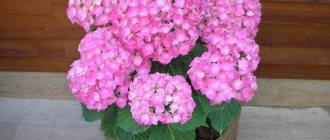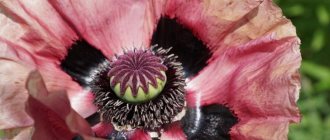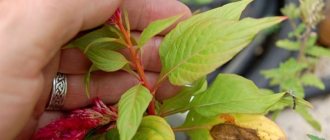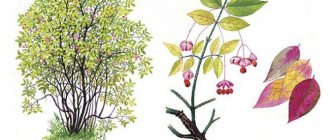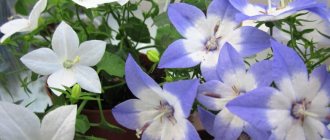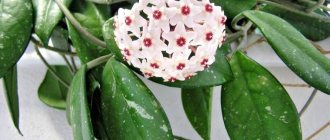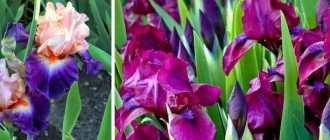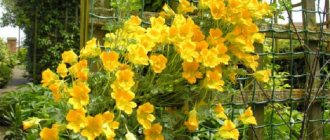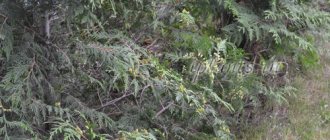The euonymus plant is a member of the Euonymus family. This genus includes approximately 190 different species. In nature, some species can grow up to 6–7 meters in height, but a bush grown indoors is much lower. This genus is represented by deciduous and evergreen trees, as well as shrubs.
Euonymus grows quite well at home. If transplants and pruning are carried out in a timely manner, the plant does not get sick because of them. This shrub is a shade-loving plant, so it can be grown on a northern windowsill. Indoor euonymus is cultivated by flower growers as an ornamental foliage plant; moreover, at home its flowering can be seen extremely rarely. It has a spectacular lush crown, and the color of the foliage may vary among different varieties.
This plant contains poison, but despite this, it is widely used in alternative medicine, and all its parts are considered healing, namely: bark, leaf blades, seeds and stems. This shrub has a large number of useful properties, for example: diuretic, expectorant and anthelmintic. Shoots and roots of euonymus are used to produce gutta-percha. In European countries it is Euonymus warty and European. The most popular among gardeners is the Japanese euonymus.
Appearance and other characteristic features of euonymus
Some natural varieties and selective hybrids of euonymus can be grown at home
Euonymus (Euonymus), also known as “pseudo-laurel”, is a genus of short, evergreen and leafless trees belonging to the Euonymus family (Celastraceae). At the moment, about 220 of its representatives are known, found throughout the Northern Hemisphere. The first scientifically described euonymus was discovered in Spain. Some varieties grow in Australia and South America.
Euonymus is often grown outdoors, but it also looks good as a houseplant.
The official name of the plant is translated from Greek roughly as “a tree with a glorious (or good) name.” "Euonymus" is one of the many nicknames by which it is known in Slavic languages. Some of them are quite unattractive - “witch’s earrings”, “wolf’s bast”, “privet”, “blind hen”. This is probably due to the fact that the juice and seeds of the euonymus are poisonous. Eating the latter may well cause death. The substances they contain negatively affect the performance of the heart.
A beautiful legend is told about the origin of the euonymus. According to her, the tree was created by an evil witch who wanted to punish people who, in her opinion, deserved it. At the last moment, the sorceress relented, leaving the possibility of using the plant as a medicine. And she herself became a robin, to which eating the fruits of the euonymus does not bring any harm. Since then, this bird has been spreading euonymus around the world, dropping its seeds to the ground.
In nature, euonymus grows up to 3–10 m in height. At home, mainly evergreen varieties are cultivated, not exceeding 1–1.5 m. Creeping and creeping species are also very popular. Any euonymus lives for about 60 years, so it will please the gardener for a long time.
Euonymus blooms and bears fruit “in captivity” extremely rarely. Besides, it's not the most attractive sight. Natural varieties have small greenish-yellow or whitish flowers collected in inflorescences in the form of a brush or umbrella of 10–15 pieces. They are almost invisible on the tree. The flowers of selective hybrids - snow-white, pinkish, purple - are more noticeable. In nature, flowering occurs in the summer; at home, it can begin even in early spring.
Euonymus flowers are rather inconspicuous
Euonymus fruits look very decorative. They are often even mistaken for flowers. These four-leaf, leathery “boxes” with spines or wings change color to bright scarlet, crimson or purple when fully ripe.
Fruiting euonymus - a real riot of colors
The main decorative value of the plant lies in the leaves, which are about 7 cm long. They are smooth, rather dense, and ovoid in shape. The color is very beautiful - soft light green, there are types with yellowish, cream or almost white splashes. The edge is cut with small teeth. The leaves are located oppositely on smooth or tetrahedral shoots covered with small growths.
Flower growers mainly grow euonymus for its decorative variegated foliage.
Description of indoor euonymus
The indoor euonymus was first described by Carl Linnaeus. It was he who gave it the scientific name eonimus, which translated means “glorious plant.”
Euonymus is an evergreen tree plant that is part of the Euonymus family. It is found in various parts of the planet Earth in areas with subtropical and temperate climates.
This genus includes low-growing shrubs and trees, which can be either evergreen or deciduous. The ribbed shoots are tetrahedral. The opposite leaf blades, leathery to the touch, have a glossy surface. The foliage can be either green or variegated. During flowering, unattractive flowers are formed that do not add decorative value to the plant. During pollination, a dry box is formed in place of the flower, inside which the seeds are located.
Varieties grown at home
Of the “natural” euonymuses, the ones that have most successfully adapted to home conditions are:
- Japanese (japonica). A small, intensively branching shrub, no more than 0.5–0.7 m high, densely covered with leaves. They are narrower than those of most euonymuses, shaped like a lancet or an elongated oval. The color of the leaf blade is rich green, sometimes with a lighter border or area along the central vein. The flowers are small, no more than 1 cm in diameter. The fruits are pinkish or pale orange boxes. It is demanding on soil nutrition and requires regular fertilizing. Moderate watering is important. The tree is sensitive to sudden changes in temperature and has difficulty escaping pest attacks. In extreme heat it drops its leaves.
- Rooting (radicans) or Fortune (fortunei). A low (1–1.2 m) creeping evergreen plant with long shoots. It branches rather weakly, but the existing shoots are tightly covered with leaves. They are small (4–5 cm long), smooth and shiny. The general background is yellow or yellow-white, with a green tint. At home you can grow them in hanging pots. The fruits are bright pink, the seeds are dark orange.
- Dwarf (compactus). Height - no more than 1 m. Leaves are small, up to 4 cm long, leathery. The tip of the leaf sharply sharpens, the edges bend slightly downwards. The color of the leaf blade is light green, with a slight yellowish tint. The leaves below are bluish-green or olive. The trunk is practically absent, the shoots are thin. Suitable for bonsai shaping. Unlike other varieties, it is more shade-loving and demanding of watering, and more often suffers from pests. Does not tolerate heat well.
- Winged (alatus). Deciduous shrub approximately 1.5–2 m high. It grows quite slowly. The ribs on the shoots look like wings, hence the name. The dark green leaves turn into bright scarlet and crimson in the fall. The fruits are deep purple. The plant is light-loving. It will survive in the shade, but will lose color saturation.
Planting and further care of an indoor tree
- Potted culture requires a loose substrate that has a weak alkaline reaction, good permeability and a lot of nutrients. If you are not going to rigidly form a flower, take a mixture of sand, humus and turf soil;
- You can add loam to the soil for the shrub. In this way, the root system will perfectly “adhere” to a small lump of earth;
- To limit the growth of the exotic beauty and make it easier to care for, the plant is planted in a small pot of the same shape as shown in the photo below. Don’t forget to drain excess moisture at the bottom of the pot;
- Planting involves maintaining the integrity of the original soil ball around the roots. A depression is made in the substrate and a bonsai tree is lowered into it, then the voids are filled with soil and compacted;
- The soil and root system of the bush must be moist.
Caring for euonymus at home after planting involves:
- In autumn - sanitary pruning;
- In summer, in extreme heat - spraying the crown;
- If the top layer of soil under the bush is dry, constant watering;
- Before active growing season – formative pruning of the crown;
- Every three to four years - replant the tree;
- Pinching side shoots that grow in summer;
- April-September (twice a month) – feeding using complex products.
Decorative shrubs feel great at home on east or west windows.
Protect the potted plant from direct sunlight, and, if possible (from spring to autumn), keep the plant in the fresh air. Bonsai should winter in a room where it will always be cool. Watering is carried out rarely and little by little; fertilizing is not required.
Optimal microclimate for the plant
Euonymus is relatively unpretentious. It will survive in different conditions. But in order for the plant to look its best, it is advisable to listen to its “requirements” and create a microclimate close to the optimal one.
Table: how to create suitable conditions for euonymus
| Factor | Recommendations |
| Location | The sill of a window facing southeast or southwest. The room must be regularly ventilated, while protecting the plant from drafts. In the summer, it is useful to send the pot to the balcony (indoor or outdoor), terrace, veranda, or garden. |
| Lighting | Most types of euonymus prefer bright light, without even suffering from direct sunlight. Variegated hybrids are more light-loving, but under direct rays they quickly “fade”, so it is advisable to shade them. |
| Temperature | The optimal temperature in summer is 22–25ºС, in winter 12–15ºС. In winter, hybrids will tolerate lower (3–5ºС), but not negative temperatures. “Natural” euonymus is not afraid of frosts down to -20ºС. If the room is too warm in winter (20ºC or more), even an evergreen euonymus will most likely lose most of its leaves. |
| Air humidity | Euonymus grows best in high humidity (60–70%), but does not suffer much from dry air. In extreme heat, you can spray the flower or periodically give it a warm shower. The last procedure is also useful for cleaning the flower from dust (once a week is enough). |
Euonymuses are mostly shade-tolerant, but not shade-loving. A compact, even crown of the bush is formed only in bright light or at least in light partial shade.
Euonymus will tolerate both shade and completely artificial light, but will not form a beautiful crown in such conditions.
General information
Euonymus is famous for its decorativeness. The greatest aesthetic value is provided by greenery, which can be painted in different colors and have an interesting natural pattern. Usually these are lush, bright bushes, but creeping and creeping varieties are also found.
In captivity, the plant usually does not bloom, and therefore does not bear fruit. Euonymus has many names among people. Most often they are associated with its toxicity. The juice and seeds of the plant are dangerous.
How to transplant euonymus correctly?
Young euonymus are replanted annually, adults - once every 2-3 years or even less often. It depends on the growth rate and how old the soil is in the pot. The procedure is carried out in early spring. For large specimens grown in tubs, which cannot be replanted purely physically, the top 5–7 cm of soil is removed and replaced with fresh substrate.
There is no need to replant particularly large specimens of euonymus; it is enough to change the top layer of soil in the pot
The size of the pot is selected so that it is 3–5 cm larger in diameter than the previous one. For slow-growing varieties, the old pot is suitable if it is sterilized and the soil is completely changed. To limit the growth of euonymus, especially in height, a container almost identical in diameter to the previous one, rather flat than deep, is suitable.
Euonymus needs slightly alkaline soil, so dolomite flour or crushed chalk (5 g per 10 l) is added to ready-made store-bought soil for decorative leafy houseplants or to a substrate mixed independently.
Dolomite flour is a useful additive for neutralizing excessive soil acidity
The soil should be light, nutritious, air and water permeable:
- Fertile turf, leaf soil, humus and coarse river sand (2:1:1:1). If you plan to grow bonsai, add 3 parts of powdered clay.
- Turf soil, peat chips, perlite or vermiculite (6:2:1).
Euonymus can be grown like a bonsai, but this requires special soil and at least minimal experience
Euonymus transplant:
- Place expanded clay or other drainage material at the bottom of the pot in a layer of about 1–1.5 cm.
- Fill about a third of the container with fresh substrate. Water the soil thoroughly. When the water is absorbed, make a depression in it.
- Remove the plant from the pot, keeping the soil ball intact if possible. You can make the process easier by watering the plant well about half an hour before.
- Transfer the flower to a new pot. Fill the voids around the edges with soil. Gently compact the soil and water the flower well again.
Since the euonymus is quite unpretentious, it does not need special care after transplantation. The flower can be immediately returned to its original place. A plant purchased in a store is replanted as quickly as possible - the heavy universal substrate does not allow water to pass through well, provoking the development of rot.
Video: how to transplant euonymus
Care calendar
In spring, dry branches need to be removed. In April and May, Euonymus should be thoroughly fertilized using mineral fertilizer. Colloidal sulfur should be used as protection against pests in the spring.
In the summer, prevention of diseases and parasites is required. Insecticides must be used.
In autumn, it is advisable to clearly form the crown. the euonymus with mineral fertilizers in the fall.
In winter, mulching of the soil is necessary. For this you need sawdust, dry leaves and peat. Sheltering Euonymus for the winter should only be done for young plants (up to three years old). Adult specimens do not need this.
How does a flower react to the grower's mistakes?
The main decorative value of euonymus is its leaves. They are a reliable “indicator” of the plant’s condition. The plant reacts to any errors in care by deteriorating its appearance.
Table: how errors in caring for euonymus manifest themselves
| What does the plant look like? | What is the reason? |
| The leaves become dull, the variegated color disappears, and the tips dry out. | The room is too dry or there is insufficient watering. Another possible reason is prolonged exposure to direct sunlight. |
| The plant sheds its leaves. | If this occurs during the active growing season, is associated with an almost complete stop of growth and affects only the lower leaves, the flower is watered too often and/or abundantly. In winter, too high temperatures and low air humidity are to blame. |
| Brown spots spread on the leaves, the bases of the petioles and shoots turn black. | Rot develops due to regular waterlogging of the soil, and the situation is aggravated by low indoor temperatures. |
| The leaves turn yellow, gradually dry out and fall off. | The plant lacks nutrients. Or the fertilizer used is not suitable for it. |
Possible problems
If the conditions of maintenance are unsuitable or if the rules of care are violated, problems may arise with indoor euonymus, for example:
- Yellowing and flying of leaf blades. Most often this occurs due to stagnation of fluid in the root system, which is caused by excessively abundant or very frequent watering. Because of this, rot may appear on the roots. Let the soil mixture in the pot dry thoroughly, and then adjust the watering. It may be necessary to replant into fresh soil mixture.
- The foliage becomes faded. As a rule, this is observed during a warm winter, especially if the air in the room is dry.
- The variegated foliage turned simply green. The bush feels a lack of light.
- The tops of the leaf blades curl and dry out. The reason is excessively intense lighting.
- Pests. Spider mites and aphids can settle on the tree.
Common diseases and pests
Euonymus is quite resistant to most fungal, bacterial and viral diseases. The exception is rot. But it is often attacked by sucking insects, which are attracted to dense, succulent leaves. But there are simple preventive measures, the observance of which will minimize the risk of infection:
- Place newly purchased indoor plants in quarantine for at least 10–12 days.
- Avoid crowding of flowers on the windowsill and place bouquets (especially roses and chrysanthemums as far away from them as possible).
- Regular inspection (preferably with a magnifying glass) for characteristic signs and damage.
- Immediate isolation of flowers at the slightest suspicion of infection, disinfection of the corresponding area of the window sill.
- Minimizing damage during pruning, replanting, immediate processing of all cuts
- Using only clean, sharp tools, sterile soil and pots.
- Maintain air humidity at a level comfortable for the flower, regularly ventilate the room.
- Weekly warm shower.
- Proper care, especially watering.
Use in landscape design
Euonymus is successfully used in landscape design. From varieties intended for cultivation in open ground, miniature hedges and lawns are formed . Large spreading specimens look good in group plantings and flower beds.
As for indoor plants, in the warm season they can also be placed in the garden. They will become a real decoration of the terrace, creating decor on the territory of a rock garden or alpine slide . They will look harmonious next to low-growing coniferous plants, adding some variety to the green background with their variegated foliage.
Pots with euonymus can be installed as a border of a flower bed, or used to decorate garden paths. The mobility of such plants has a great advantage in that it makes it possible to periodically change the landscape picture throughout the summer . In autumn, plants must be brought indoors.
Methods for propagating euonymus
Rooting cuttings
Rooting cuttings is the most common method of vegetative propagation of euonymus. During the replanting process, you can also divide a large bush into 2-3 smaller ones or transplant the “offshoots” that appear at the roots into separate containers. The best time to root cuttings is late spring or early summer.
You can get euonymus cuttings during the pruning process.
- Cut a few healthy, young, non-woody shoots from the plant. Cut cuttings from them 5–8 cm long so that each has at least one internode. Make all cuts with a sharp, clean knife and sprinkle with crushed chalk, activated carbon, colloidal sulfur, or at least cinnamon.
- Fill small cups with fertile soil, pouring a 5–7 cm thick layer of coarse sand on top.
- Plant the cuttings in the ground, sprinkling the lower cut with any powdered root formation stimulator.
- Place the containers in transparent plastic bags and tie them. Or cover with glass jars.
- Provide bright light, a temperature of about 22ºC, and moderate watering as the soil dries. If you alternate water and biostimulator solution and turn on the bottom heating, the rooting process will go faster. In less comfortable conditions, roots will appear in 1.5–2 months.
- Wait the same amount of time and transplant the cuttings into soil for adult plants. After 2-3 months, pinch the plants to make the bushes more luxuriant.
Euonymus cuttings take root rather slowly
Video: propagation of indoor plants by apical cuttings
Popular varieties of Japanese indoor euonymus with names and photos
In indoor floriculture, the following varieties of euonymus are most often used:
Latifolius Albomarginatus
Characterized by dark green leaf blades with a wide light border.
Luna
Greenish-yellow leaves with green edges.
Albomarginatus
Rich green leaves with a narrow white edge.
Mediopictus
The middle of the leaf blades is yellow, the edges are green.
How does cutting occur?
Important factors that ensure high-quality propagation of euonymus by cuttings are the good condition of the stems, timely protection from sunlight, and the supply of moisture, oxygen and heat. It is worth noting that too early contact with the sun can cause the death of seedlings. Dry soil will also negatively affect their condition.
Euonymus propagation by cuttings occurs as follows:
- it is necessary to cut off the required number of cut shoot tips with internodes. It is recommended to take cuttings from plants that are five or more years old.
- Carefully treat each cut with the root, which will contribute to the active formation of the root system.
- Plant the prepared cuttings in sandy-peaty soil. It is recommended to do this in a greenhouse, where it is warm enough and optimal conditions are maintained for rapid growth.
- The grafting procedure is usually carried out in the summer (June-July), and good roots appear already in the fall, which indicates that the euonymus is prepared for planting in a permanent place of growth.
Euonymus varieties such as Krylaty, Maaka, Big-winged, and Sacred are propagated by cuttings. But for broad-leaved, cork varieties, this method of breeding is not suitable.
How to care for a plant
Euonymus is distinguished by its masculine, stern character. But, like any man, this bush cannot do without careful care. This includes watering and feeding, keeping the crown clean and trimming it. Otherwise, your euonymus will become like a “neglected garden.”
Water and feed
From spring to autumn, euonymus loves to drink plenty of water. He is not too picky, but still prefers more refined drinks to chlorinated tap water. Rain, melt, filtered or at least settled lukewarm water. To determine frequency, monitor the condition of the topsoil. As soon as it dries out, water it.
In the summer heat, the euonymus will be happy to be sprayed, but the water should also be soft and warm. You can even wash the plant under a gentle shower. Do not forget to keep the leaves clean; dusty euonymus not only looks bad, but also develops slowly.
With the arrival of autumn cold weather, water procedures must be stopped. It is enough just to wipe the foliage from dust with a damp cloth from time to time. An exception is euonymus left in warm, hot rooms; they will also suffer from dry air, and spraying will be appropriate.
The euonymus bush must be kept clean
Watering in autumn and winter should be limited. When kept cold, reduce to a minimum. If an euonymus overwinters on a glassed-in balcony, it is practically not watered.
During the active growth of shoots and leaves, in spring and summer, the euonymus will respond well to feeding. You can alternate organic and mineral complexes, adding them to irrigation water every two to three weeks. Any fertilizer for ornamental leafy plants is suitable; euonymus is not very picky. In winter, when he rests in the cool, food should be stopped.
Trimming the euonymus
When kept in a room, euonymus practically does not bloom; its main advantage is its beautiful crown. Therefore, it requires regular pruning and pinching. Moreover, sometimes a useful haircut needs to be done more often than once a year. Euonymus responds very well to pruning.
Usually the bush is pruned at the very end of winter. First of all, thin, elongated branches are removed. To increase bushiness, pinch the tops of the shoots. Thus, they stimulate the awakening of dormant lateral buds. If you want to grow a tree, cut off the lower shoots, leaving a bare stem and a lush “cap” on top.
Euonymus lends itself well to formation
In summer, pinch shoots regularly to improve branching. In the fall, carry out hygienic pruning. Cut out weak, dried branches, if necessary, update the shape of the crown.
Skilled flower growers form various shapes from the crown of euonymus. It can be given a spherical, cone-shaped or cubic appearance. Plants from which bonsai are grown are pruned according to special rules.
We provide peace
The rest time for euonymus is winter. Deciduous forms, even when grown indoors, change the color of the foliage in the fall, and then completely or partially shed it. Evergreen varieties should retain their leaves. But in excessively dry and warm air, they can also fall off. To stop leaf fall, you need to lower the temperature in the room.
Deciduous euonymus do not change their natural habits even at home; in the fall they change the color of the foliage and then shed it
Already in November, watering the plants is gradually reduced, feeding is canceled - during dormancy this is unnecessary. And the euonymus needs bright lighting even in winter.
